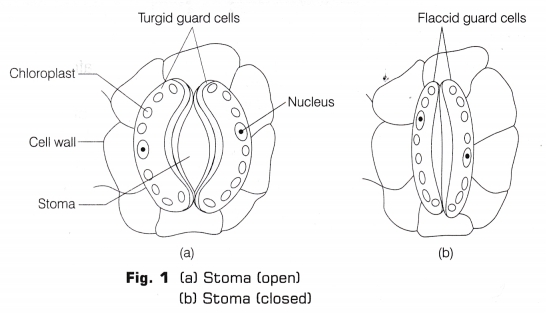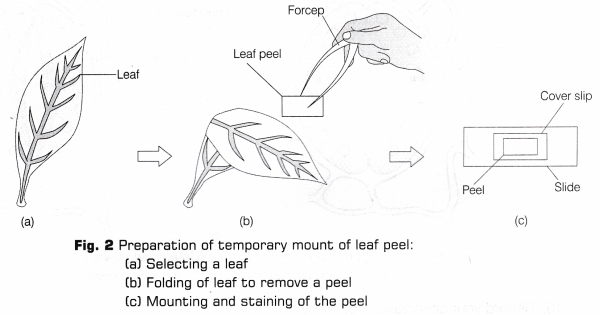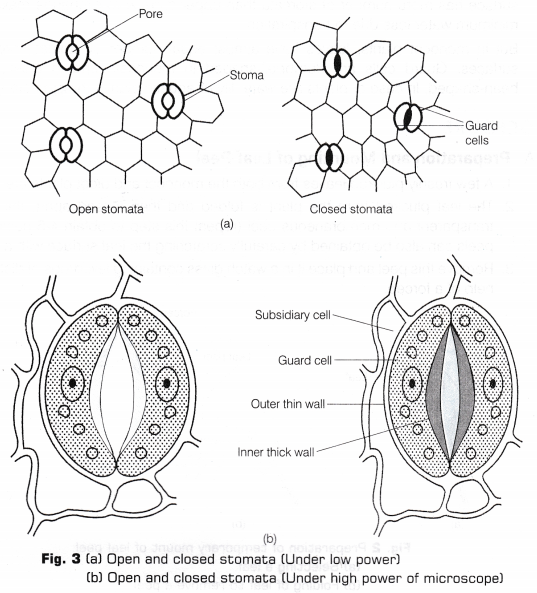CBSE Class 10 Science Lab Manual – Stomata
Aim
To prepare a temporary mount of a leaf peel to show its stomata.
Materials Required
Fresh leaves from a dicot (either Petunia, Dianthus or Solanum) and a monocot (either lily, maize or grass) plants, needle, forceps, brush, glycerine, watch glass, slide, cover slips, safranin solution, blotting paper, distilled water and a compound microscope.
Theory/Principle
The leaves in a plant are its flat, green part originating from the nodes of stems on its branches.
In plants, physiological processes such as respiration and photosynthesis involve exchange of gases between plant tissues and the external atmosphere. This occurs through minute microscopic pores called stomata (singular, stoma) present in the leaf.
The stomata is an elliptical pore which are found on the surface of leaves, i.e. both the upper and lower epidermis. These minute pores possess chloroplasts and are enclosed by two-kidney shaped guard cells on its either side.
These guard cells have a thin outer and thick inner walls and they regulate the opening and closing of the stomatal pores, i.e. when guard cells are turgid, the stomata will be open [Fig.1(a)] and when guard cells become flaccid, the stomata will close [Fig.1(b)].

The number, distribution and the type of stomata varies in different plants. Even the variation is visible between the upper and lower epidermis of a single plant ip dicots, i.e. lower epidermal surface has more number of stomata than upper surface to exchange maximum oxygen with minimum water loss due to transpiration.
But in monocot plants, leaves have almost equal number of stomata present on both the surfaces. Guard cells are dumbbell-shaped In monocots and in dicots, guard cells are bean-shaped. In case of plants like water lily or aquatic plants, the stomata are absent,
Procedure
- Preparation and Mounting of Leaf Peel
- A few freshly plucked leaves from both the monocot and dicot plants are taken [Fig. 2(a)],
- The leaf plucked from the plant is folded and then teased apart, this produces a thin, transparent and membraneous peel (repeat this step to obtain 4-5 peels) [Fig. 2(b)], Leaf peels can also be obtained by carefully scratching the leaf surface with a razor blade.
- Remove this peel and place it in a watch glass containing few drops of distilled water with the help of a forcep.

- Staining of Leaf Peel
- To the watch glass containing leaf peel, add 1-2 drops of safranin ^solution and wait for 1-2 minutes.
- With the help of a brush, transfer this stained peel in the centre of a clean and dry slide.
- Add one drop of glycerine just over the peel, present in the centre of the slide.
- Using a needle, very gently place a cover slip over the peel [as shown in Fig. 2(c)].
- Excess glycerine is wiped off using a piece of blotting paper.
- The slide is observed under the microscope. First observation is done in low magnification(10x) [Fig. 3(a)], then higher magnification is used (45x) [Fig. 3(b)].

- Record your observations carefully.
- Repeat this experiment with the leaves of other plants.
Observation
An observation table is compiled with all recorded information after viewing the slide under both magnifications of microscope.
| S. No. | Observation | Dicot | Monocot |
| 1. | Number of stomata in the microscopic field | ||
| 2. | Number of epidermal cells in the microscopic field | ||
| 3. | Shape of guard cells (bean-shaped or dumbbell-shaped) | ||
| 4. | Number of chloroplasts in each guard cell |
Careful observation of leaf peels in both dicots [Fig. 4(a)] and monocots [Fig. 4(b)] confirm the presence of stomata in their leaf.

Result
In the leaves of both the rnonocot and dicot plants, very small or miniature openings called stomata were present surrounded by guard cells on the either sides of it.
In Monocot Leaves
- The stomata are equally present on both the epidermal surfaces, i.e. upper and lower surfaces in leaf.
- Guard ceils are distinct dumbbell-shaped.
In Dicot Leaves
- The stomata are present on both surfaces, however the number of stomata is much more in lower surface compared to upper surface.
- Guard cells are of bean or kidney-shaped.
Precautions
- Always use a freshly plucked leaf for isolating a peel.
- The peel should not be allowed to dry. therefore place it in water soon after removing.
- Clean and dry slide should be used.
- Keep the stain on slide for 1-2 minutes only to avoid over-staining.
- Formation of air bubbles during placement of cover slip should be avoided.
- Ensure that peel is placed on the centre of the slide.
- While wiping off the excess water, place the blotting sheet on slide and use very soft/gentle press.
Viva – Voce
Question 1.
What is the function of guard ceils in stomata? [NCERT]
Answer:
Guard cells regulates the opening and closing of the stomata depending on the state they are in, i.e. whether they are turgid or flaccid.
Question 2.
Why is the number of stomata greater on the lower surface of a dicot leaf? [NCERT]
Answer:
Stomata helps in gaseous exchange and transpiration. The sides least exposed to the sun rays, i.e. lower surface of leaf has more number of stomata so that the plant can exchange maximum oxygen with minimal water loss.
Question 3.
Why are stomata absent in roots? [NCERT]
Answer:
Roots are present underground in the soil hence, the stomatal functions will be blocked. Also, stomata are used for transpiration hence, there presence is observed in leaves.
Question 4.
What is the shape of guard ceils in stoma of grass leaf? [NCERT]
Answer:
Grass is a monocot plant in which the guard ceil is dumbbellshaped.
Question 5.
Do guard cells have a rigid or elastic walls? Justify your answer. [NCERT]
Answer:
Guard celts regulate the opening and closing of stomatal cells, when they are turgid or flaccid respectively. Hence, there walls are elastic which facilitates the changes in their shape due to change in the level of water and salts at the given time.
Question 6.
Guard cells are different from other epidermal cells in what context?
Answer:
Guard cells have chloroplasts while other epidermal cells lack in it. Shape of guard cells is different in monocots (dumb-bell) and dicots (bean), while epidermal cells are irregular in shape in both.
Question 7.
The number of stomata is same in all plants. True/false, give reason supporting your answer.
Answer:
False. All plants have different number of stomata. It depends on the habitat and type of plant. Even the number of stomata are different within a single leaf like in a dicot leaf where upper surface has less number of stomata than lower surface.
Question 8.
Can you suggest any two factors which cause stomata to close?
Answer:
Two factors that can cause, stomata to close are
- Absence of light
- Lack of carbon dioxide in the atmosphere.
Question 9.
What happens, if we do not keep the isolated peel in water?
Answer:
The peel will dry up and become useless.
Question 10.
Before conducting this experiment, if the plant is keptln dark, what will be the condition of stomata?
Answer:
Stomatal pore will be closed.
Question 11.
Staining of the leaf peel plays what role in the observations?
Answer:
The leaf peel is transparent, thus the cells present in it, will also be transparent. Staining helps in precise observation of cells.
Question 12.
Name a plant in which stomatas are absent.
Answer:
Aquatic plant Hydrilla.
Question 13.
Name a plant hormone which can cause stomatal closure.
Answer:
Abscisic Acid (ABA).
Question 14.
Why do guard cells bend, when they swell up?
Answer:
The guard cells bend because of the differential thickenings of its inner and outer walls. The inner wall of guard cell is thicker and less stretchable as compared to the outer wall.
Science Lab ManualScience Practical SkillsScience LabsMath LabsMath Labs with Activity
